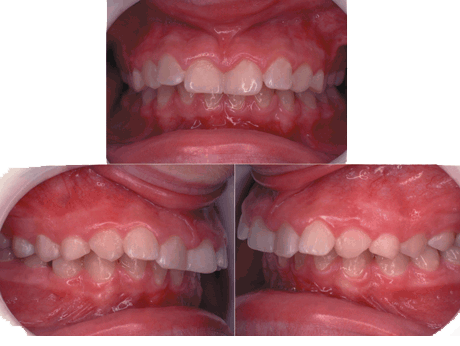Introduction
The persistency
of the deciduous teeth can be often seen in the transitional period from
deciduous to permanent dentition1, usually in the region of
the lower incisors and upper canines. In those cases, the permanent
teeth erupted despite the deciduous teeth did not exfoliate. The
extraction of primary teeth in these cases is necessary, and treatment
procedure achieves the alignment of permanent teeth to the normal
position in the dental arch.
The aim of this paper was to describe a treatment of female patient, 13
years of age, with dentoalveolar class II division 1.malocclusion due to
persistency of both upper deciduous canines.
The case report
The girl, 13 year of age, was referred to the Clinic of orthodontics, Faculty of Stomatology in Belgrade, for treatment of protruded upper anterior teeth.
Extraoral findings (fig.1); Intraoral findings (fig.2).
The face was symmetric, with good vertical proportion. The profile was slightly convex, with prominent upper lip.
|
|
|
|
Fig. 1 Facial appearance at the beginning of the treatment. |
Fig. 2 Occlusion at the beginning of the treatment. |
The completely permanent dentition was found, with persistency of both upper deciduous canines. These teeth were placed between the permanent canines and first bicuspids. The Angle class I molar and class II canine relationships were found. The amount of overbite was 5mm, and overjet 8mm.
Gnathometric findings:
Slight crowding in the region of upper anterior teeth was found, with normal values for jaw with, and protrusion of upper anterior teeth.
Radiographic findings:
Ortopantomograph showed that all third permanent molars were present. Cephalometric analysis shoved skeletal class I jaws relationship, labial position of upper incisors, good vertical proportions, and slight horizontal growth rotation pattern of the lower jaw.
Treatment plan:
It was decided to extract both upper deciduous canines, to moved distally permanent ones, and to retract incisors.
Treatment progress:
Ten days after deciduous canine’s extraction, the separations rings were places between second bicuspid, and first and second molars in the upper and lower jaws. Few days lather, upper and lower fixed appliances (Ricketts .018 prescription) were bonded, and figure 8 ligature wire were placed to the upper canines2. Alignment and leveling was started with .014’’NiTi archwires in both arches, continued with .018 NiTi and .016x.022’’NiTi archwires respectively. After 5 months leveling was achieved, and distal movement of permanent canines started3 by using elastic chain on the stainless steel .016x.022’’ archwire. After 4 months, the retraction of upper incisor started by “sliding mechanics”2, and lasted 3 months. After another 3 months of finishing, the fixed appliances were removed, and Essix retainers4 were used for next 12 months.
Treatment results:
The treatment with fixed appliances lasted 15 months, continued with retention period for 12 months. After treatment, the facial esthetic was improved (fig. 3), due to upper incisors retrusion, and upper lip retraction. Intraoral examination showed Angle class I molars and canines occlusion, and both overjet and overbite were corrected (fig.4).
|
|
|
| Fig. 3 Facial appearance after treatment. | Fig. 4 Occlusion after treatment. |
Conclusion
Fixed orthodontic
appliances are necessary when bodily movement of the teeth is indicated,
as the case of this patient.
Literature
1. Marković M (Ur.): Ortodoncija.
Ortodontska sekcija Srbije, Beograd, 1982.
2. McLaughlin R, Bennett J, Trevisi H: Systemized orthodontic treatment
mechanics. Mosby International Ltd., 2001.
3. Bishara S: Orthodontics.W.B. Saunders Company, 2001.
4. McNamara J, Burdon W: Orthodontics and orthopaedic treatment in mixed
dentition. Needham Press, 1993.
2 Dravska str.
11000 Belgrade
Serbia and Montenegro
e-mail: glisa@EUnet.yu
- Copyright © 2003 by The Editorial Council of The Acta Stomatologica Naissi



